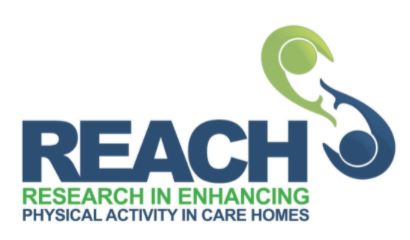Research project
Development and testing of strategies to enhance physical activity in care homes (REACH)
Description
Objectives and brief methodology
The project aims to develop and preliminary test strategies to enhance physical activity in the daily life routines of care home residents to improve their physical, psychological and social well-being.
One consequence of an ageing population is a steady increase in demand for long-term care. Residents in long-term care are particularly high users of hospital services and admissions to hospital are disruptive to their well-being. Observational research has reported that many care home residents spend the majority of their time inactive, with low levels of interaction with staff. This leads to increased dependency and low mood.
Although one way to increase activity is for physiotherapists to provide exercise classes, with the limited number of such staff available this is an unrealistic option for many. We have reviewed the evidence for ways to increase activity in residents which have been of benefit. One approach is to enhance routine activity, for example promoting activities of daily living such as walking to the toilet, walking to the dining room, and making the most of routine opportunities to promote activity. We propose a programme of research to work with care home staff and residents to develop and test methods to enhance activity.
Five overlapping workstreams will be undertaken.
Workstream 1: we will undertake observational (ethnographic) work to test the understandings we have gained from previous work within a wider range of care homes. Work will include observations and interviews to clarify our thinking on barriers, opportunities and factors that indicate that a care home (and their staff) are open to change.
Workstream 2: Clarification of measures We aim to improve levels of physical activity and therefore require a valid and reliable measure of activity in a population of frail older people. In development work we have identified activity monitors (accelerometers) as possible measures and propose to test these with a larger population of residents and evaluate newly developed physical activity questionnaires.
Workstream 3: Using information obtained in the development work and previous workstreams we will use techniques of intervention mapping to develop practical mechanisms for increasing activity and appropriate methods of implementation (for example, training materials).
Workstream 4: Working with action groups (which will include residents and staff) in four care homes we will refine the proposed mechanisms and methods to promote practical implementation in a range of care home settings.
Workstream 5: We will undertake a feasibility study in 12 care homes, to test for feasibility and effect on physical function, mood and quality of life; and to gather data to inform a future large scale trial.
Publications and outputs
Participant criteria
This research is being undertaken in care homes for older people, run by an independent provider (private, voluntary or non-profit making). We aim to be inclusive of the majority of residents in these homes. However, residents that are unwell, bed-bound, or near to death will not be included in any aspect of the study.
Patient recruitment and on-going engagement for the current projects
This research programme has been developed and refined by on-going interaction with the Bradford Care Home Forum: a group of care home owners and managers who meet alternate months to discuss all issues relating to provision of services and support within their homes. Forum members have welcomed the suggestion of finding ways to increase physical activity amongst residents, and acknowledged the difficulties of providing exercise classes in which many residents do not want to participate. We have visited homes and discussed our work with residents. We sought advice on methods, particularly the acceptability of researchers undertaking observations — it was considered acceptable providing privacy was respected. A lay co-applicant on the programme bid assisted in the development work for this proposed programme and is a continuing member of the Programme Management Group.
Recruitment of care homes: Selected homes are purposefully different from each other in terms of size, setting and ownership and urban/ rural setting. One of the homes selected has a dementia unit in order to enhance our knowledge and understanding of residents with dementia. We have selected homes that report success in encouraging engagement with activities, and others which have achieved more limited success in this regard.
Recruitment of participants: Care Home Managers have provided their consent for this study to be undertaken. Notices have been put around care homes recruited so far notifying participants of the research we will be undertaking, and informing them that they may be approached by researchers to see if they want to take part in the study. Researchers are approaching care home residents and their relatives/friends as well as staff, and asking them if they would be interested in taking part in this research.
Publications and outputs
Crocker T, Forster A, Young J, Brown L, Ozer S, Smith J, Green J, Hardy J, Burns E, Glidewell E, Greenwood DC. Physical rehabilitation for older people in long-term care. Cochrane Database Syst Rev 2:CD004294 2013
Further information
This summary presents independent research funded by the National Institute for Health Research (NIHR) under its Programme Grants for Applied Research Programme (Development and preliminary testing of strategies to enhance routine physical activity in care homes, RP-PG-1210-12017). The views expressed are those of the author(s) and not necessarily those of the NIHR or the Department of Health and Social Care.


